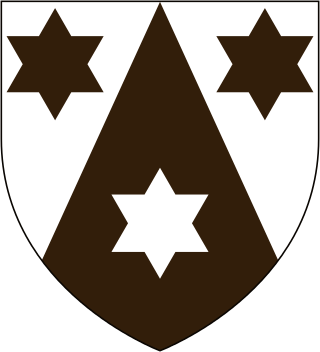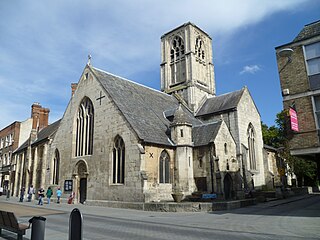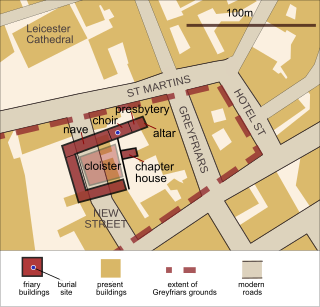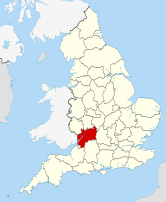
The Palace of Placentia, also known as Greenwich Palace, was an English royal residence that was initially built by prince Humphrey, Duke of Gloucester, in 1443. Over the centuries it took several different forms, until turned into a hospital in the 1690s. The palace was a place designed for pleasure, entertainment and an escape from the city. It was located at Greenwich on the south bank of the River Thames, downstream from London.

Blackfriars, Gloucester, England, founded about 1239, is one of the most complete surviving Dominican black friaries in England. Now owned by English Heritage and restored in 1960, it is currently leased to Gloucester City Council and used for weddings, concerts, exhibitions, guided tours, filming, educational events and private hires. The former church, since converted into a house, is a Grade I listed building.
Austin Friary was an Augustinian friary in Bristol, England. It was established in 1313, when Simon de Montecute gave 100 square feet (9.3 m2) of land within the Temple Gate of Bristol. Further gifts of land were made by William de Montecute and Thomas of Berkeley during the next thirty years.

Greyfriars, in Bristol, England, was a Franciscan friary. The name Greyfriars derived from the grey robes worn by the friars. It was founded at some time before 1234, within the town walls and then moved to Lewin's Mead in 1250. The site included extensive gardens surrounded by a stone wall. Following the Dissolution of the Monasteries in the sixteenth century, the premises were leased to the town council in 1541, who desired to use the stone to make repairs to the town walls, and the harbour facilities. In succeeding centuries many different uses have been made of the site, which is currently occupied by an office block and part of Bristol Dental School.
Whitefriars was a Carmelite friary on the lower slopes of St Michael's Hill, Bristol, England. It was established in 1267; in subsequent centuries a friary church was built and extensive gardens developed. The establishment was dissolved in 1538.
Exeter Greyfriars was a Franciscan friary in Exeter, Devon, England. It was founded in the earlier part of the 13th century, before 1240, and was dissolved in 1538.
Colchester Greyfriars, otherwise the Franciscan Friary, Colchester, was a Franciscan friary in Colchester, Essex, England, situated to the north of the town's east gate. It was founded sometime before 1237. In 1309 the friars received a grant of half an acre of land from Robert Fitzwalter, Lord Fitzwalter, on which he built their church. According to John Weever, the antiquarian, in his Ancient Funerall Monuments, Fitzwalter became a friar here himself in 1325, and was buried here.
Wotton under Edge Friary was a friary of the Crutched Friars in Wotton-under-Edge, Gloucestershire, England.

Whitefriars, also known as the White Friars or The College of Carmelites, Gloucester, England, was a Carmelite friary of which nothing now survives.

Greyfriars, Stamford was a Franciscan friary in Stamford, Lincolnshire, England. It was one of many religious houses suppressed and closed during the Dissolution of the Monasteries in the 16th century. The site is now part of the NHS Stamford and Rutland Hospital.

The Greyfriars, Lincoln was a Franciscan friary in Lincolnshire, England. The surviving building is the remains of the infirmary of the friary, built of dressed stone and brick and dating from c.1230, with mid-19th-century additions. The clay tile roof of the main building is in a poor condition and the Welsh slate roof of the 19th-century extension has been repaired.

Boston Friary refers to any one of four friaries that existed in Boston, Lincolnshire, England.
Greyfriars, Shrewsbury was a friary in Shropshire, England.

In London, the Greyfriars was a Conventual Franciscan friary that existed from 1225 to 1538 on a site at the North-West of the City of London by Newgate in the parish of St Nicholas in the Shambles. It was the second Franciscan religious house to be founded in the country. The establishment included a conventual church that was one of the largest in London; a studium or regional university; and an extensive library of logical and theological texts. It was an important intellectual centre in the early fourteenth century, rivalled only by Oxford University in status. Members of the community at that time included William of Ockham, Walter Chatton and Adam Wodeham. It flourished in the fourteenth and fifteenth century but was dissolved in 1538 at the instigation of Henry VIII as part of the Dissolution of the Monasteries. Christ's Hospital was founded in the old conventual buildings, and the church was rebuilt completely by Sir Christopher Wren as Christ Church Greyfriars after the original church was almost completely destroyed in the Great Fire of London of 1666. The building now standing on the site, designed by Arup Group Limited, is currently occupied by Merrill Lynch.

St Mary de Crypt Church, Southgate Street, Gloucester, is an Anglican Church, which was first recorded in 1140 as The Church of the Blessed Mary within Southgate. It is in the Diocese of Gloucester and is located adjacent to the ruins of Greyfriars. It has also been known as Christ Church and St. Mary in the South. St Mary de Crypt is a Grade I listed building.

Greyfriars, Leicester, was a friary of the Order of Friars Minor, commonly known as the Franciscans, established on the west side of Leicester by 1250, and dissolved in 1535. Following dissolution the friary was demolished and the site levelled, subdivided, and developed over the following centuries. The locality has retained the name Greyfriars particularly in the streets named "Grey Friars", and the older "Friar Lane".
Greyfriars, Dumfries, was a friary of the Friars Minor, commonly known as the Franciscans, established in Dumfries, Scotland. Following dissolution the friary was demolished and the site levelled. The locality has retained a reference to the friary in the street named "Friars Vennel". The present neo-Gothic Greyfriars was built from 1868 and is located at the site of the former Maxwell's Castle at the top of High Street.












